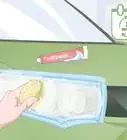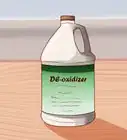This article was co-authored by Duston Maynes. Duston Maynes is an Automotive Repair Specialist at RepairSmith. Duston specializes in leading a team that handles a variety of automotive repairs including replacing spark plugs, front and rear brake pads, fuel pumps, car batteries, alternators, timing belts, and starter motors. Duston holds an Associate’s degree in Automotive/Diesel Technology from The Universal Technical Institute of Arizona and is a Certified Diagnostic Technician and Automobile Mechanics Technician through BMW STEP. RepairSmith received The 2020 Big Innovation Award by Business Intelligence Group and The Startup of the Year by the American Business Awards. RepairSmith was also included in Built in LA’s 50 Startups to Watch and The Business Intelligence Group’s 52 Names Leading the Way in Customer Service. RepairSmith offers in-home services to provide car owners convenient and complete auto repair everywhere.
This article has been viewed 390,902 times.
A blown out low beam bulb can make it difficult to see at night and driving with your high beams on all the time can make it difficult for other drivers to see. Fortunately, fixing a bad low beam is a straight forward process in the majority of vehicles that can be done by most people without just a few hand tools. If replacing your headlight bulb does not work, there may be an electrical issue in your vehicle that should be addressed by a professional.
Steps
Preparing to Replace a Low Beam Bulb
-
1Identify a blown out bulb. You can often tell when a headlight blows out while you’re driving, but confirm which bulb has actually blown out by leaving your headlights on and getting out of the vehicle to check. Then get back in your vehicle and turn on your high beams. Some vehicles use a single bulb for both high and low beams while others do not.[1] If the high beam on the same side is also out, it may be one bulb.[2]
- You do not need to purchase specific bulbs for each side, but identifying which is the blown out bulb will help you to replace it without having to start the vehicle again.
- If neither the low or high beams work on the same side, there could also be an electrical issue preventing the bulbs from getting power.
-
2Purchase a replacement bulb. It’s important that you get the correct bulb for your year, make and model vehicle. Try asking the clerk at your local auto parts store to look it up in their system, or try checking the auto maker’s website for the code indicating which headlight to use.[3]
- Headlight codes are usually comprised of letters and numbers like H11B or D3S.
- You can find the proper code for your vehicle at websites such as www.lightbulbs4cars.com as well.
Advertisement -
3Gather the necessary tools. Swapping a low beam bulb can require varying amounts of work. While some cars may require no tools at all, others may require specialized tools to help remove portions of the trim under the hood, or even the bumper and grill. Refer to the service manual for your specific vehicle for a comprehensive list of tools required for the job. Most vehicles require only a screw driver or nothing at all to gain access to the headlight housing.[4]
- After referring to the service manual for your vehicle, visually inspect the area around the headlight in yours to ensure it looks the same as it does in the manual.
- If you purchased your vehicle used, flat head screws may have been replaced with Philips head screws or other components may have been swapped out during repairs by the previous owner.
-
4Disconnect the battery. Be sure you remember which side of the car has a blown out low beam bulb before disconnecting the battery. To disconnect it, use a hand or socket wrench of the appropriate size to loosen the nut holding the ground cable onto the negative terminal of the battery. You don’t need to remove the nut, just loosen it enough to slide the cable off of the terminal, then tuck the cable to the side of the battery.[5]
- Tucking the cable will prevent it from popping up and coming into contact with the negative terminal of the battery.
- You will not need to disconnect the positive terminal.
Removing the Old Bulb
-
1Remove any necessary trim pieces. In many vehicles, you will need to remove a piece of trim that separates the headlight assembly from the engine bay. This plastic piece often extends the width of the car, but in some there may be individual pieces for each headlight. In some newer GM vehicles, you may also need to remove the front bumper cover in order to access the headlight assemblies.[6]
- Refer to the service manual for your specific vehicle to better understand what pieces of the vehicle will need to be removed to access the headlights.
- Be careful not to break plastic fasteners or snaps your vehicle may use to hold trim pieces in place.
- Replacement fasteners and snaps of most kinds can be purchased at your local auto parts store.
-
2Locate the headlight bracket or holder. Many newer vehicles use a plastic headlight housing to hold the headlight bulb in place, while some others use a metal or plastic bracket. Use your vehicle’s service manual to locate the bracket or holder, then remove the headlight and wire pigtail from it. In many vehicles, you will only need to twist the headlight a quarter turn counter clockwise and pull it out straight back to remove it.[7]
- If you have to remove any bolts from a headlight assembly bracket, make sure to keep them someplace safe until you reassemble that portion of the car.
- In some vehicles, you will need to unbolt the headlight assembly and slide it out of the car to access the headlight bulb itself in the back.
-
3Disconnect the wires going to the headlight. The headlight bulb should still be in a socket connected to wiring coming from your vehicle. Disconnect the wires by unclipping them from the bottom of the headlight bulb housing and pull on it gently to disconnect it. Ensure you pull on the plastic clip and not the wires, as you may accidentally pull them out of the headlight bulb housing, causing your headlights to fail to function.[8]
- Be careful unsnapping the clip. They are often made of brittle plastic and may break easily.
- If you break the clip, you can secure it in place with a single strip of electrical tape, or purchase a replacement clip to solder in place of the old one.
-
4Pull the headlight bulb out of the bulb housing. Place your index finger and thumb as low as possible at the base of the bulb and pull to remove it from the bulb housing.[9] Do not pinch the larger portion near the top of the bulb as it may crack or break and cut you. A broken bulb is significantly harder to remove.[10]
- If you break the bulb, use a pair of pliers to remove what is left in the bulb housing.
- Discard the blown out bulb in the trash once complete.
Installing a New Headlight Bulb
-
1Remove the bulb from the package using gloves or a tissue. The oil on your hands can compromise the glass of the bulb, reducing its lifespan. Protect your bulb from this by wearing gloves or using a tissue any time you come into contact with the glass of the new low beam headlight bulb. Be careful not to drop the bulb as you remove it from the package.[11]
- If you touch the bulb, use rubbing alcohol and a paper towel or rag to wipe it off.
-
2Slide the new bulb into place. Keep your gloves on or the bulb in a tissue as you slide it into the bulb housing.[12] Be careful not to apply too much pressure to the top of the bulb as you press it in to avoid cracking or breaking the glass. Make sure the bulb is seated firmly in the bulb housing so it has a solid electrical connection.[13]
- You may need to press on the top of the bulb to get it to fit in properly, just be careful not to push too hard.
- If you feel like you have to force the bulb in, it may not be the correct bulb for your vehicle.
-
3Connect the wiring to the bulb assembly. Take the wiring pigtail you disconnected from the bulb previously and reattach it to the back of the bulb assembly with the new headlight bulb in it. Make sure the clip snaps into place and holds the wiring pigtail firmly. If the wires come loose while you are driving, the headlight will stop working.[14]
- The headlight bulb and assembly should now be connected to the car once again.
- Be careful not to yank on the assembly with it connected, as you may rip a wire out of the harness.
-
4Slide the bulb assembly back into the headlight housing. Wipe the bulb off again with rubbing alcohol if you feel it may have come into contact with your skin, then slide it into the headlight housing.[15] Turn the bulb assembly a quarter turn clockwise to re-secure it, or reinstall the bracket that held your headlight bulb in place.[16]
- Tug on the headlight bulb assembly once it is secure to make sure it’s held firmly in place.
- Make sure to use the same bolts you removed to secure the bracket if equipped.
-
5Reinstall the trim pieces and reconnect the battery. With the headlight completely reassembled, replace the trim pieces you removed in the opposite order you took them off in. Many trim pieces overlap, so it’s important to put them back on in the proper order.[17]
- Reconnect the battery once the trim has been reassembled.
- Turn the headlights on and check to make sure the new bulb works.
Expert Q&A
-
QuestionWhat would cause one headlight to not work?
 Duston MaynesDuston Maynes is an Automotive Repair Specialist at RepairSmith. Duston specializes in leading a team that handles a variety of automotive repairs including replacing spark plugs, front and rear brake pads, fuel pumps, car batteries, alternators, timing belts, and starter motors. Duston holds an Associate’s degree in Automotive/Diesel Technology from The Universal Technical Institute of Arizona and is a Certified Diagnostic Technician and Automobile Mechanics Technician through BMW STEP. RepairSmith received The 2020 Big Innovation Award by Business Intelligence Group and The Startup of the Year by the American Business Awards. RepairSmith was also included in Built in LA’s 50 Startups to Watch and The Business Intelligence Group’s 52 Names Leading the Way in Customer Service. RepairSmith offers in-home services to provide car owners convenient and complete auto repair everywhere.
Duston MaynesDuston Maynes is an Automotive Repair Specialist at RepairSmith. Duston specializes in leading a team that handles a variety of automotive repairs including replacing spark plugs, front and rear brake pads, fuel pumps, car batteries, alternators, timing belts, and starter motors. Duston holds an Associate’s degree in Automotive/Diesel Technology from The Universal Technical Institute of Arizona and is a Certified Diagnostic Technician and Automobile Mechanics Technician through BMW STEP. RepairSmith received The 2020 Big Innovation Award by Business Intelligence Group and The Startup of the Year by the American Business Awards. RepairSmith was also included in Built in LA’s 50 Startups to Watch and The Business Intelligence Group’s 52 Names Leading the Way in Customer Service. RepairSmith offers in-home services to provide car owners convenient and complete auto repair everywhere.
Automotive Repair Specialist To diagnose the problem, you will have to go through a process of elimination. First, remove the bulb and check if there's any kind of discoloration. If the bulb looks fine, try swapping it with the other side to check if there's power getting to the headlight. If the problem persists, check the igniter or the fuses to see if the headlight is getting power.
To diagnose the problem, you will have to go through a process of elimination. First, remove the bulb and check if there's any kind of discoloration. If the bulb looks fine, try swapping it with the other side to check if there's power getting to the headlight. If the problem persists, check the igniter or the fuses to see if the headlight is getting power. -
QuestionHow do you check a headlight?
 Duston MaynesDuston Maynes is an Automotive Repair Specialist at RepairSmith. Duston specializes in leading a team that handles a variety of automotive repairs including replacing spark plugs, front and rear brake pads, fuel pumps, car batteries, alternators, timing belts, and starter motors. Duston holds an Associate’s degree in Automotive/Diesel Technology from The Universal Technical Institute of Arizona and is a Certified Diagnostic Technician and Automobile Mechanics Technician through BMW STEP. RepairSmith received The 2020 Big Innovation Award by Business Intelligence Group and The Startup of the Year by the American Business Awards. RepairSmith was also included in Built in LA’s 50 Startups to Watch and The Business Intelligence Group’s 52 Names Leading the Way in Customer Service. RepairSmith offers in-home services to provide car owners convenient and complete auto repair everywhere.
Duston MaynesDuston Maynes is an Automotive Repair Specialist at RepairSmith. Duston specializes in leading a team that handles a variety of automotive repairs including replacing spark plugs, front and rear brake pads, fuel pumps, car batteries, alternators, timing belts, and starter motors. Duston holds an Associate’s degree in Automotive/Diesel Technology from The Universal Technical Institute of Arizona and is a Certified Diagnostic Technician and Automobile Mechanics Technician through BMW STEP. RepairSmith received The 2020 Big Innovation Award by Business Intelligence Group and The Startup of the Year by the American Business Awards. RepairSmith was also included in Built in LA’s 50 Startups to Watch and The Business Intelligence Group’s 52 Names Leading the Way in Customer Service. RepairSmith offers in-home services to provide car owners convenient and complete auto repair everywhere.
Automotive Repair Specialist You have to make a series of tests on different parts of the headlight system. Remember to make sure the car is turned off and the headlights are off before starting. If you want to be extra safe, disconnect the native battery cable before testing the bulbs, avoiding shorts and electrical shocks.
You have to make a series of tests on different parts of the headlight system. Remember to make sure the car is turned off and the headlights are off before starting. If you want to be extra safe, disconnect the native battery cable before testing the bulbs, avoiding shorts and electrical shocks. -
QuestionI replaced my headlight bulb, but the low beams still aren't working. What am I doing wrong?
 Community AnswerThere may be a blown fuse or the wiring leading to your headlights may have been compromised. First, locate the headlight fuse and make sure it is intact. If it is, use a voltmeter to see how much power, if any, is reaching the headlights. If there is no power reaching them, there is a break in the wiring somewhere between the fuse panel and the headlights themselves.
Community AnswerThere may be a blown fuse or the wiring leading to your headlights may have been compromised. First, locate the headlight fuse and make sure it is intact. If it is, use a voltmeter to see how much power, if any, is reaching the headlights. If there is no power reaching them, there is a break in the wiring somewhere between the fuse panel and the headlights themselves.
References
- ↑ Duston Maynes. Automotive Repair Specialist. Expert Interview. 14 July 2021.
- ↑ http://www.dmv.org/how-to-guides/headlight.php
- ↑ http://www.dmv.org/how-to-guides/headlight.php
- ↑ http://www.dmv.org/how-to-guides/headlight.php
- ↑ http://www.dmv.org/how-to-guides/headlight.php
- ↑ http://www.military.com/off-duty/autos/how-to-change-headlight-bulb.html
- ↑ http://www.military.com/off-duty/autos/how-to-change-headlight-bulb.html
- ↑ http://www.military.com/off-duty/autos/how-to-change-headlight-bulb.html
- ↑ Duston Maynes. Automotive Repair Specialist. Expert Interview. 14 July 2021.
- ↑ http://www.military.com/off-duty/autos/how-to-change-headlight-bulb.html
- ↑ http://www.military.com/off-duty/autos/how-to-change-headlight-bulb.html
- ↑ Duston Maynes. Automotive Repair Specialist. Expert Interview. 14 July 2021.
- ↑ http://www.dmv.org/how-to-guides/headlight.php
- ↑ http://www.dmv.org/how-to-guides/headlight.php
- ↑ Duston Maynes. Automotive Repair Specialist. Expert Interview. 14 July 2021.
- ↑ http://www.dmv.org/how-to-guides/headlight.php
- ↑ http://www.dmv.org/how-to-guides/headlight.php
About This Article
To fix a low beam headlight, first leave your headlights on and get out of your vehicle to verify which side has the blown-out bulb. Then, purchase a replacement bulb that matches the year, make, and model of your vehicle. Disconnect your car battery by loosening the nut holding the ground cable on the negative terminal of the battery. You will also likely need to remove the trim separating the headlight assembly from the engine bay. Next, find the headlight bracket or holder and remove the headlight and wire pigtail. Disconnect the wires leading into the headlight and pull the bulb from the bulb housing. Now, remove the new bulb from its package using gloves or a tissue. Slide the bulb gently into the bulb housing, then connect the wiring pigtail you disconnected and reattach it to the back of the bulb assembly. Put the bulb assembly back into the headlight housing, reinstall the trim pieces, and reconnect the battery. For more details on how to polish your new headlight bulb, see below.


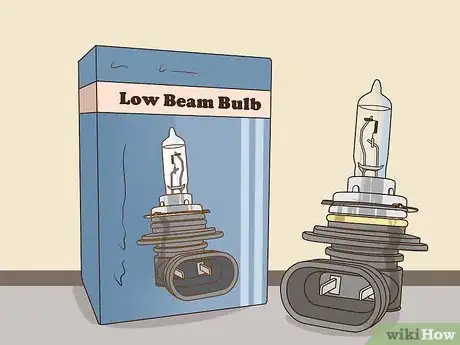


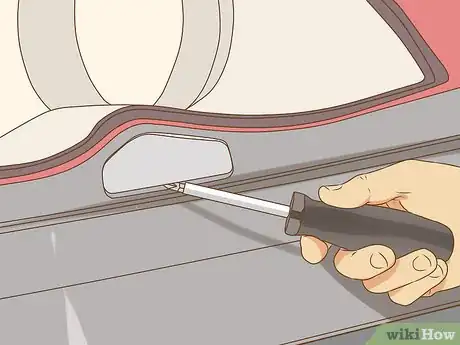
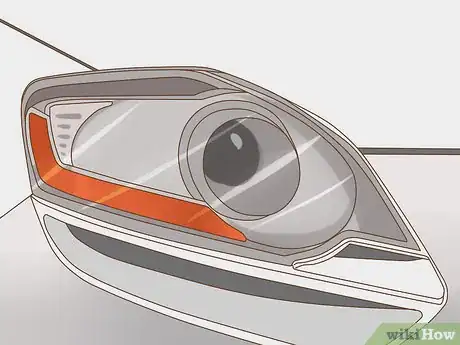
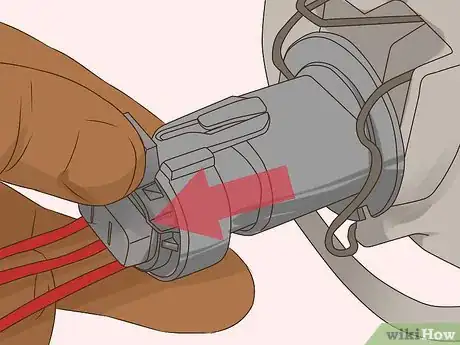









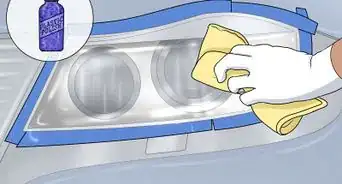
-Step-27.webp)














